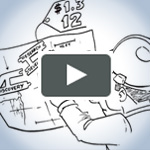The Will Hendon Fund’s HOPE Under the Stars Celebrates 5th Anniversary and Raising Nearly $2 Million Locally for Juvenile Batten Disease
HOPE Under the Stars began as a grassroots event for The Will Herndon Fund for Juvenile Batten Disease Research at Beyond Batten Disease Foundation in the Rob Fleming park five years ago with a mission of HOPE to help fund a treatment or cure for the devastating and fatal condition Juvenile Batten Disease affecting then, 6 year old Will Herndon, of The Woodlands. This year, expecting a crowd of more than 700 guests, the 5th Annual HOPE Under the Stars event will be held at a new venue to accommodate a growing crowd of continued and new supporters. The Texas chic event will be at The Woodlands Waterway Marriott Hotel and Convention Center in The Woodlands, Texas on Saturday, September 21, 2013. Doors open at 5:30 pm with a cocktail reception and silent auction. Missy and Wayne Herndon, Will’s parents, will kick-off the program at 7 pm with a research update while guests enjoy a southwestern inspired dinner. The celebration will celebrate the amazing support of The Woodlands community and honor Charlotte and Craig Benson for their work in establishing Beyond Batten Disease Foundation. A live auction will follow the presentation. Much loved New Orleans brass band, The Bucktown All-Stars, will entertain the crowd.
Throughout the evening, guests will have the opportunity to ride a mechanical bull, capture the moment in a photo booth and pose for a souvenir “butt sketch”. A special “HOPE Lounge” created especially for sports fans, will feature a cigar bar, casino tables and showcase the evening’s SEC Football game. Adjacent to the dance floor will be a “HOPE Hideaway” where guests can take a moment away from the excitement to catch up with friends, new and old. Sponsorships and tickets are available at www.willherndon.org or by calling 409-454-9330.
“Our mission is simple: Find a treatment to SAVE WILL. We started HOPE Under the Stars in November 2009, in The Woodlands, to assist in fulfilling our mission. Each year since, this event has grown, providing the means to accelerate research into a treatment and a cure for Juvenile Batten Disease,” said Missy Herndon, Will’s mom, Fund founder. “We are in a literal race against time to save Will and hundreds of children like him. Private funding is crucial to meet our mission. The Woodlands, Houston and Austin communities are helping to make that possible, having contributed nearly $2 Million to date. We are so grateful and full of promise that a treatment is on the horizon”
Beyond Batten Disease Foundation supports research to treat and cure Batten disease, which is a rare, fatal, inherited, neurodegenerative disorder that strikes young children, including 10 year old Will Herndon of The Woodlands. The condition initially causes blindness and seizures, progressively impairs cognitive and motor capacities, and then ultimately results in death during the late teens or early twenties. The Foundation recently co-funded a research library where eleven drug discovery centers across the globe will share promising drug compounds that could treat neurodegenerative disease like Batten disease, Alzheimer’s and Multiple Sclerosis.
Craig and Charlotte Benson of Austin created Beyond Batten Disease Foundation in 2008 after their daughter, Christiane, was diagnosed with Batten disease. In 2009, Wayne and Missy Herndon launched The Will Herndon Fund as part of the Foundation in honor of their son, Will. For more information, visit www.willherndon.org.
###
Ten year old Will Herndon (center), suffering from juvenile Batten Disease and the inspiration for The Woodlands’ HOPE efforts with a few HOPE Under the Stars. Committee Members preparing for an evening of friendship and HOPE: (L-R) Julie Lile, Angela Gibbs, Nicole Murphy (Event Chair), Will Herndon, Missy Herndon (Will’s Mom and Fund Founder), Carey Bell, DeAnn Guidry, Stevi Venable

![committeephoto2013[1]](http://dev.beyondbatten.org/wp-content/uploads/2013/08/committeephoto20131-300x200.jpg)

